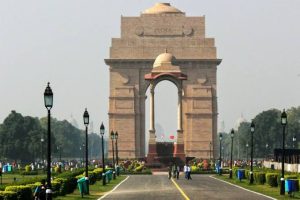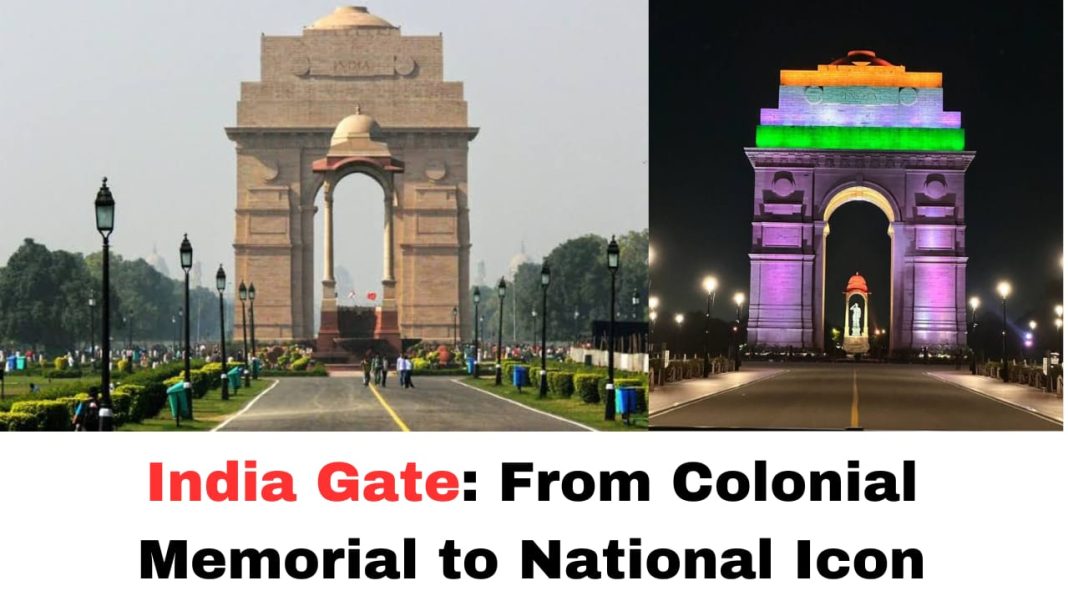Digital News Guru Delhi Desk:
India Gate: A Timeless Tribute to Valor and Heritage
India Gate, an iconic structure standing tall in the heart of New Delhi, is one of India’s most celebrated landmarks. Designed by Sir Edwin Lutyens and completed in 1931, this grand war memorial is not only an architectural marvel but also a poignant symbol of sacrifice, history, and unity. Each year, millions of visitors flock to this majestic structure, drawn by its historical significance and its enduring role as a beacon of patriotism and heritage.
The Architecture and Design
India Gate is an imposing 42-meter-tall archway built from sandstone, reminiscent of the Arc de Triomphe in Paris. Lutyens drew inspiration from classical European styles, blending them seamlessly with Indian motifs to create a monument that resonates with both grandeur and solemnity. The structure is adorned with intricate carvings, including the names of over 13,000 Indian and British soldiers who perished in World War I and the Third Anglo-Afghan War.

Situated at one end of the ceremonial Rajpath, India Gate forms the core of New Delhi’s architectural and cultural landscape. The structure’s symmetrical design and its placement amidst sprawling lawns and water bodies make it a prominent focal point in the city’s layout.
A Monument to Bravery
India Gate was originally constructed as a war memorial to honor the soldiers of the British Indian Army who laid down their lives during World War I and subsequent campaigns. Inscribed on its surface are the words: “To the dead of the Indian armies who fell and are honored in France and Flanders, Mesopotamia and Persia, East Africa, Gallipoli and elsewhere in the near and the far East and in sacred memory also of those whose names are here recorded and who fell in India on the North-West Frontier and during the Third Afghan War.”
In 1971, following the Indo-Pakistani War, another significant addition was made to India Gate: the Amar Jawan Jyoti, or the Flame of the Immortal Soldier. This eternal flame burns in tribute to the soldiers who sacrificed their lives in the 1971 war that led to the creation of Bangladesh. The Amar Jawan Jyoti is guarded by ceremonial sentries and serves as the site of solemn military rituals on significant national occasions.

India Gate in National Celebrations
India Gate takes center stage during the annual Republic Day parade, held every January 26th. The parade showcases India’s military prowess, cultural diversity, and achievements, making it a spectacular event watched by millions. Dignitaries, including the President of India, foreign guests, and citizens, gather to honor the nation’s heritage and progress.
Beyond Republic Day, India Gate serves as a venue for numerous events, including cultural festivals, exhibitions, and rallies. The monument and its surrounding gardens also become a hub for locals and tourists during evening hours, offering a serene escape amidst the hustle and bustle of the city.
Cultural and Emotional Significance
India Gate is more than just a war memorial; it is a space where personal and collective emotions converge. For families, it is a recreational spot. For photographers, it is an endless source of inspiration. For history enthusiasts, it is a living chronicle of India’s journey through colonial rule and its path to independence.
The lawns surrounding India Gate, particularly the Children’s Park, attract families and visitors looking for leisure. During summer evenings, the site buzzes with activity as vendors sell snacks, ice creams, and souvenirs, while children play and people relax under the starry sky. The monument’s atmosphere transforms into a scene of warmth and camaraderie, emphasizing its dual role as a site of remembrance and a place of joy.
Challenges and Preservation Efforts
As one of India’s most visited landmarks, India Gate faces challenges related to urbanization, pollution, and the impact of tourism. Airborne pollutants, combined with Delhi’s extreme weather conditions, have taken a toll on the sandstone structure over the years. Periodic cleaning and restoration projects are carried out to ensure its longevity and maintain its pristine appearance.
Authorities have also taken steps to preserve the sanctity of the monument. Security measures, waste management systems, and awareness campaigns are implemented to encourage responsible tourism. With a focus on sustainable heritage management, the government continues to balance the monument’s role as a public space and its status as a protected historical site.
The Icon in Modern Times
India Gate remains a powerful symbol of India’s past and present. It has been featured extensively in literature, films, and media, often serving as a backdrop for narratives of patriotism, love, and resilience. Its enduring presence on postcards, currency notes, and memorabilia ensures that its image is etched into the collective memory of the nation.
In recent years, the addition of the National War Memorial, inaugurated in 2019, has complemented India Gate’s significance. Located nearby, this modern structure honors the sacrifices of soldiers from post-independence conflicts, connecting the legacy of India Gate with contemporary military history. Together, these monuments form a continuum of remembrance that binds generations of soldiers and citizens.

Visiting India Gate
A visit to India Gate is a must for anyone exploring New Delhi. The monument is easily accessible and offers a variety of experiences for visitors. During the day, the sunlight highlights the intricate details of its architecture, while at night, the structure is illuminated, creating a mesmerizing spectacle.
Guided tours and informational kiosks provide insights into the history and symbolism of India Gate, enriching the visitor experience. The adjacent Rajpath and Rashtrapati Bhavan add to the allure of the area, making it a comprehensive destination for sightseeing.
Conclusion
India Gate stands as a timeless testament to bravery, sacrifice, and unity. It embodies the essence of a nation that honors its past while looking forward to its future. As a structure, it is awe-inspiring; as a symbol, it is irreplaceable. For citizens and visitors alike, India Gate is not merely a monument but a living reminder of the values that define India’s spirit. Whether viewed as a historical landmark or a vibrant public space, it continues to inspire awe and reverence, ensuring its place in the heart of the nation for generations to come.
You May Also Read: Jaipur-Ajmer Highway: Fire After Truck Collision, 5 Dead, Over 35 Injured








